Similar Posts
The Sacred Arts Initiative
“Rethinking Sacred Arts”
A Review
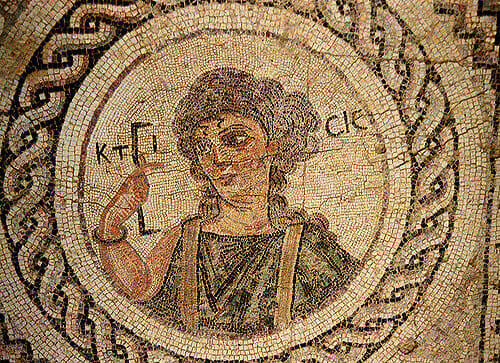
Ktisis (Creation) holding a measuring rod. A nearby inscription reads: “This house…has now girt itself with the much venerated symbols of Christ.” House of Eustolios, Kourion, Cyprus. Floor Mosaic, 5th Century. Commentary on the significance of this image can be found in the audio of the panel discussion.
Although the task of OAJ has mainly been to work towards the promotion of the revival of traditional Orthodox liturgical arts, along the way we have not hesitated to engage the sphere of secular art. This has not only been relegated to a critique of its predominantly misplaced values and fragmentation, as can be clearly seen in much of contemporary gallery art, but also has touched on how it can in fact unexpectedly, in its best moments and even inadvertently becomes a channel of great beauty and the fragrance of the Sacred. Whether we call these rare yet profound instances exemplary of “threshold art” or “art of the portico,” as Aidan Hart has put it, it goes to show how at times we just need to step back a bit and “rethink” things we might have cast out of our minds as a possibility within a non-liturgical context.
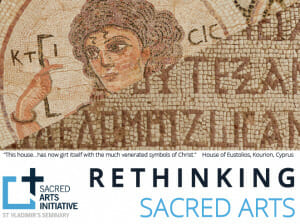 So how are we then to understand, in a more comprehensive way, art’s capacity to serve as a vehicle of the Sacred? What do we really mean by “sacred art?” These are the kinds of questions, among many others, that were tackled at a weekend symposium titled, “Rethinking Sacred Arts,” which gathered at the St. Vladimir Orthodox Theological Seminary, September 16-18, 2016. The participants were a group of esteemed international scholars and artists, who drew from their respective disciplines and expertise in exploring theological, philosophical, historical and socio-cultural categories, as a way of engaging new ways of thinking about “sacrality” and “art.”
So how are we then to understand, in a more comprehensive way, art’s capacity to serve as a vehicle of the Sacred? What do we really mean by “sacred art?” These are the kinds of questions, among many others, that were tackled at a weekend symposium titled, “Rethinking Sacred Arts,” which gathered at the St. Vladimir Orthodox Theological Seminary, September 16-18, 2016. The participants were a group of esteemed international scholars and artists, who drew from their respective disciplines and expertise in exploring theological, philosophical, historical and socio-cultural categories, as a way of engaging new ways of thinking about “sacrality” and “art.”
The symposium included as one of its highlights a public panel discussion held on Saturday evening (Sep. 17), which was attended by an audience of at least 75 people. The participants brought to the table many illuminating angles and perspectives, converging and complementary points were explored, and some questions from the audience further enriched the discussion. This was the first among a group of forthcoming events planned between Fall 2016 and Spring 2018 by the Seminary, all of which are a part of its Sacred Arts Initiative (SAI) funded by a grant from the Henry Luce Foundation. The SAI has been launched to explore the intersection of human creativity and holiness. It also aims to explore what an integrated theological study of sacred arts at SVOTS could look like.
The symposium was coordinated by Peter C. Bouteneff, professor of Systematic Theology at the Seminary and director of the SAI, along with Dn. Evan Freeman, seminary alumnus and Ph.D. candidate in the Department of the History of Art at Yale University, Richard Schneider, professor of Iconology and Hermeneutics at the Seminary, and Megan Carlisle Rakowski, a trained archivist and seminary alumna.
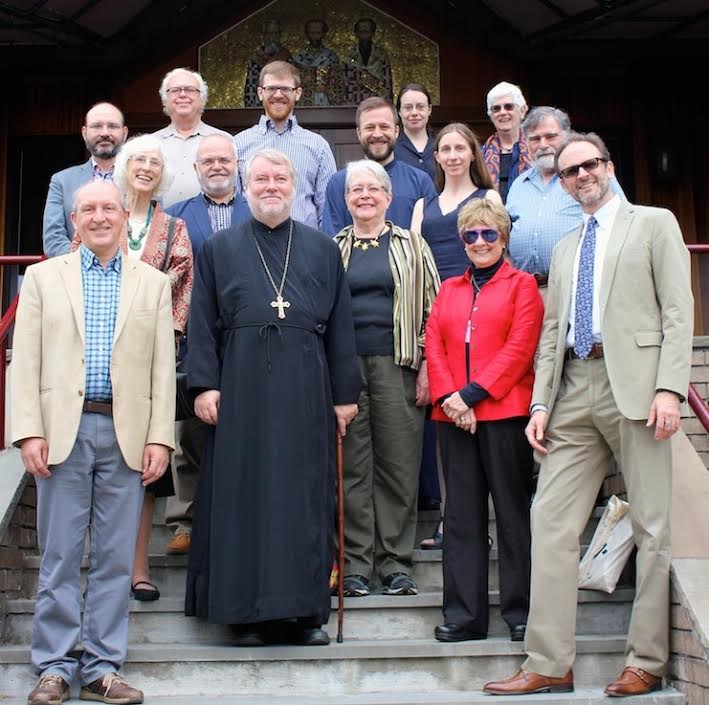
Sacred Arts Symposium participants on the steps of Three Hierarchs Chapel, St. Vladimir’s Seminary (photo: Mary Honoré)
The participants represented a wide spectrum of confessional beliefs and disciplines, three of which were within the Orthodox Tradition: sacred music composer Fr. Ivan Moody, chairman of the International Society for Orthodox Church Music and currently a researcher at CESEM-Universidade Nova de Lisboa; Vasileios Marinis, associate professor of Christian Art and Architecture at the Yale Institute of Sacred Music and Divinity School; and George Kordis, iconographer and former professor in Iconography (Theory and Practice) at the University of Athens.
The rest of the participants consisted of: Gordon Graham, Henry Luce III Professor of Philosophy and the Arts, Princeton Theological Seminary; Helen C. Evans, Mary and Michael Jaharis Curator for Byzantine Art, The Metropolitan Museum of Art; Annemarie Weyl Carr, University Distinguished Professor of Art History, Southern Methodist University (Emerita); Peter Jeffery, Michael P. Grace Chair in Medieval Studies and Professor of Musicology and Ethnomusicology, Notre Dame University; Margot Fassler, Keough-Hesburgh Professor of Music and Liturgy, University of Notre Dame; Judith Wolfe, senior lecturer in Theology and the Arts, University of St. Andrews, Scotland; and Mary Carruthers, professor of English, New York University (Emerita) and Quondam Fellow of All Souls College, Oxford.
Frankly speaking, when first hearing about the panel discussion I thought the notion of “rethinking” the sacred arts as potentially problematic, to say the least. I wondered, “What is there to ‘rethink,’ really?” It seemed to imply a kind of “deconstructive” approach that smacked of revisionist irreverence. However, after attending the event it became clear that there was really no cause for alarm. There was no attempt at “reinventing” or “reimagining” sacred art as such. It mainly consisted of an exploration and clarification of what the word “sacred” really means in the context of “art” and vice versa. As Prof. Bouteneff explained: “In thinking freshly about what it means to call something ‘sacred’ our symposium participants reflected on the dialogical relationship between God and the human person. It is in the human response to God that we create and partake in objects, spaces, words, and sounds that bring us to the encounter with and praise of God.”
The panel could have greatly benefited from the inclusion of many more Orthodox voices, both professional artists and scholars. As it was it seemed unbalanced. But perhaps this was the point, an invitation for scholars already exploring aspects of art and the sacred to consider the unique model the Orthodox liturgical experience has to offer. For as Prof. Bouteneff noted, “Our symposiasts also spoke appreciatively of the unique contribution that the Orthodox world can offer in reflecting theologically on the material world, on human creativity, and on the coming together of the sacred arts in the context of the Liturgy.” So although the panel came across more as assessment from the “outside” rather than from the “inside” of an Orthodox of ethos, nevertheless, it seems certain that much was gained by both sides from the discourse.
SAI is definitely worth keeping an eye on. With the various events and projects it will coordinate in the future it can help fill a gap in supplying a level of rigorous discourse and engagement with the secular artistic sphere that has been lacking. We’ve been needing a discussion as to how the Liturgy as a “complete work of art” ripples and reverberates out into all aspects of life, even touching the realm of non-liturgical, or, as Fr. Ivan Moody has put it, para-liturgical art. As I’ve said before, not everyone is called to paint icons, become a chanter or conduct a Church choir. Nevertheless, there are many Orthodox Christians that are professional secular artists. So it is very important to explore theologically how secular art can indeed become an expression of the holy in its own way and level of efficacy.
In a way SAI parallels and complements the efforts of OAJ. If the former, on the one hand, is more engaged in the scholarly and academic side of things, it could be said that the latter, on the other hand, focuses more on the practical application of principles. Nevertheless, as mentioned in the beginning, there are convergences in our discourse, so hopefully more convergences will arise. I just hope that in their exploration of what an integrated theological study of sacred arts could look like, they consider not only the academic and theoretical side of things, but also the possibility of incorporating into the curriculum a rigorous course of practical training for iconographers. A crucial component if there is ever going to be an “integrated” approach to the theological study of sacred arts.
The next SAI event will be an international conference, titled, “Sounding the Sacred,” May 1- 4, 2017, which will continue the work of the Arvo Pärt Project at St. Vladimir’s Seminary.
An audio recording of the “Rethinking Sacred Arts” public panel discussion and a photo gallery is available online. The SAI also has a website with more information. There you will also find an article by Prof. Bouteneff titled, Sacred Arts: Beginning a Conversation, which is definitely worth a read, since it insightfully clarifies, in a very direct and brief way, some of the theological principles to keep in mind as guidelines when discussing such an important and yet potentially tenuous topic as sacredness in secular art.

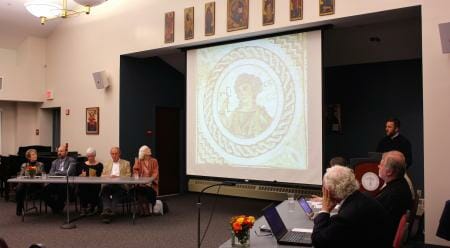
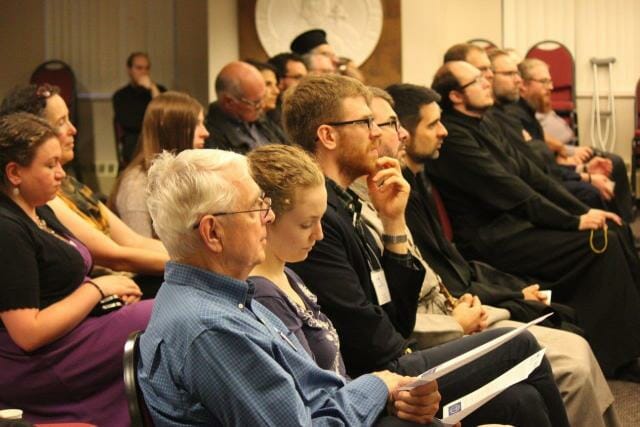
Dear Father – Thank you for sharing the proceeding with the broader community. I look forward to reading the materials. The notion of ‘Threshold” art which I assume was not the subject of the conference is also an interesting one. Thank you once again for all your contributions and support.
Hello Lesia – Thank you for your support as well. I just added links to the “threshold art” and “art of the portico” articles in the text for easy access. See the first paragraph.
Thank you Father. I am working on a new series that I have entitled threshold …. http://lesiamaruschak.com/the-cave-triptychs-maruschak It maybe of interest. Blessings Always Lesia
Thanks for the link Lesia. I’ll take a look. May the Lord bless you.